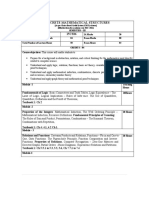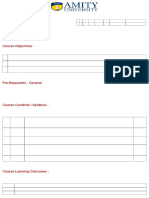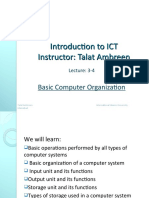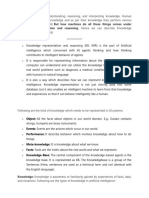0 ratings0% found this document useful (0 votes)
82 viewsCourseOutline - Discrete Structures Fall 2022
CourseOutline - Discrete Structures Fall 2022
Uploaded by
roseThis document provides information about the CS102 - Discrete Structures course offered at the International Islamic University, Islamabad during the Fall 2022 semester. The course is a 3 credit hour course that introduces foundational discrete mathematics concepts for computer science and software engineering. Topics covered include logic, proofs, sets, relations, functions, induction, recursion, graphs, trees, and counting principles. The course aims to develop students' logical reasoning abilities and understanding of finite problem structures. Assessment is based on quizzes, assignments, a midterm, and a final exam. No late assignments or makeups for missed work will be accepted.
Copyright:
© All Rights Reserved
Available Formats
Download as DOC, PDF, TXT or read online from Scribd
CourseOutline - Discrete Structures Fall 2022
CourseOutline - Discrete Structures Fall 2022
Uploaded by
rose0 ratings0% found this document useful (0 votes)
82 views4 pagesThis document provides information about the CS102 - Discrete Structures course offered at the International Islamic University, Islamabad during the Fall 2022 semester. The course is a 3 credit hour course that introduces foundational discrete mathematics concepts for computer science and software engineering. Topics covered include logic, proofs, sets, relations, functions, induction, recursion, graphs, trees, and counting principles. The course aims to develop students' logical reasoning abilities and understanding of finite problem structures. Assessment is based on quizzes, assignments, a midterm, and a final exam. No late assignments or makeups for missed work will be accepted.
Original Title
CourseOutline_Discrete Structures Fall 2022
Copyright
© © All Rights Reserved
Available Formats
DOC, PDF, TXT or read online from Scribd
Share this document
Did you find this document useful?
Is this content inappropriate?
This document provides information about the CS102 - Discrete Structures course offered at the International Islamic University, Islamabad during the Fall 2022 semester. The course is a 3 credit hour course that introduces foundational discrete mathematics concepts for computer science and software engineering. Topics covered include logic, proofs, sets, relations, functions, induction, recursion, graphs, trees, and counting principles. The course aims to develop students' logical reasoning abilities and understanding of finite problem structures. Assessment is based on quizzes, assignments, a midterm, and a final exam. No late assignments or makeups for missed work will be accepted.
Copyright:
© All Rights Reserved
Available Formats
Download as DOC, PDF, TXT or read online from Scribd
Download as doc, pdf, or txt
0 ratings0% found this document useful (0 votes)
82 views4 pagesCourseOutline - Discrete Structures Fall 2022
CourseOutline - Discrete Structures Fall 2022
Uploaded by
roseThis document provides information about the CS102 - Discrete Structures course offered at the International Islamic University, Islamabad during the Fall 2022 semester. The course is a 3 credit hour course that introduces foundational discrete mathematics concepts for computer science and software engineering. Topics covered include logic, proofs, sets, relations, functions, induction, recursion, graphs, trees, and counting principles. The course aims to develop students' logical reasoning abilities and understanding of finite problem structures. Assessment is based on quizzes, assignments, a midterm, and a final exam. No late assignments or makeups for missed work will be accepted.
Copyright:
© All Rights Reserved
Available Formats
Download as DOC, PDF, TXT or read online from Scribd
Download as doc, pdf, or txt
You are on page 1of 4
International Islamic University, Islamabad
Fall 2022
Faculty of Computing
Department of Software Engineering
Course Information
Course Code & Course Title: Lab: No
CS102 – Discrete Structures Credit hrs: 3
Prerequisites For the Course: None
Instructor: Neelum Inam Course TA: None
E-mail : neeluminam@yahoo.com E-mail: None
Text Book:
1. Discrete Mathematics and its applications, Kenneth H Rosen, 7th Edition.
Reference Book:
1. Discrete Mathematics with Applications,Susanna Epp's, 4th Edition.
2. Discrete Mathematical Structures, Kolman, 4th Edition
Course Objectives:
Introduces the foundations of discrete mathematics as they apply to Computer Science,
focusing on providing a solid theoretical foundation for further work. Further, this course
aims to develop understanding and appreciation of the finite nature inherent in most
Computer Science problems and structures through study of combinatorial reasoning,
abstract algebra, iterative procedures, predicate calculus, tree and graph structures.
Educational Outcomes
Students will be able to:
1. Use logical notation to define and reason about fundamental mathematical
concepts such as sets, relations, functions, and integers.
2. Evaluate elementary mathematical arguments and identify
fallacious reasoning (not just fallacious conclusions).
3. Synthesize induction hypotheses and simple induction proofs.
4. Prove elementary properties of modular arithmetic and explain their applications
in Computer Science.
5. Apply graph theory models of data structures and state machines to solve
problems of connectivity and constraint satisfaction, for example, scheduling.
6. Problem solve and study in a small team with fellow students.
Course Outline
The purpose of this course is to understand and use discrete structures that are backbones of
computer science/software engineering. Later courses in the computer science/software
engineering curriculum build on the mathematical foundations covered here. In particular, this
class is meant to introduce logic, proofs, sets, relations, functions, mathematical induction,
recursion, graphs, trees and counting principles, with an emphasis on applications in computer
science/software engineering.
Tentative Lecture Plan:
Week Topic Activity
1. Introduction, Assignment 1
Course outline and class policies discussion
Logic
Introduction to logic, Propositions, Propositional Logic,
Conditional Statements, Converse, Contrapositive and
Inverse,
2. Logic(contd.) Assignment 1 Submission
Logic and Bit Operations, Proofs, Valid and Invalid
Arguments
Propositional Equivalences, Predicates
Truth tables, Constructing new Logical Equivalences,
Predicate Logic
3. Quantifiers Assignment 2
Predicate Calculus, Universal Quantifier, Existential Quiz1
Quantifier, Binding Variables, Negations, Translating from
English into Logical Expressions, Nested Quantifiers, Order
of Quantifiers, Translating Statements involving Nested
Quantifiers.
4. Rules of inference Assignment 2 Submission
Valid arguments, Proof by Contradiction
5. Generating Functions
6. Sets and Operations on Sets
Venn Diagram, Power Set, Cartesian Product, Using Set
Notation with Quantifier, Union, Intersection, Set identities,
Computer Representation of Sets.
7. Functions Quiz2
One to One Functions, Onto Functions, Bijection, Inverse
Functions, Compositions of Functions, Graph of Functions
Sequences and Summations
Arithmetic Progression, Special Integer Sequences,
Geometric Progression
8. Mid Term Examination
9. Mid Term Discussion
Basics of Counting
Basic Counting principles, Sum Rule, Product Rule
10. Counting Principles
Basic Counting principles, Sum Rule, Product Rule, The
Inclusive-Exclusive Principle,Tree diagrams,
11. Pigeonhole Principle Quiz3
Boxes Principle, Generalized Pigeonhole Principle,
Applications
Graphs
Terminology and special types of graphs, bipartite graph,
New Graph from Old
12. Relations Assignment 3
Function as relations, Relations on Set, Properties of
Relation, Combining Relations, Equivalence Relations,
Partial Ordering
13. Graph Coloring Assignment 3 Submission
Introduction, Application of Graph Coloring
14. Euler and Hamilton Paths
Euler Path and Circuits, Hamilton Path and Circuits
15.
Trees
Rooted Tree(m-ary tree),Ordered Rooted Tree, Trees as
Model, Properties of Tree, Tree Traversal
16. Revision
Grading and General Course Policies:
Assignments and/or grade percentages are subject to change. The breakdown is as follows:
Quizzes 15%
Assignments 5%
Mid Term 20%
Final____ _________________ 60%__
Total 100%
Students will submit all assignments individually.
Come prepare in every class for a surprise quiz.
You are responsible for timely and functional delivery of assignment to CR on submission date. Late
assignments will result in zero marks.
Assignments will be graded on the basis of adhering to requirements, robustness, analytical
reasoning/explanation, documentation, user-interface and above all originality.
No makeup quiz/exam/assignment will be taken.
Students are responsible to ensure that their attendance does not fall below specified limit.
You might also like
- DP Math Analysis Unit Plan - Number and Alegbra (Core SL-HL)Document8 pagesDP Math Analysis Unit Plan - Number and Alegbra (Core SL-HL)Raymond Meris83% (6)
- Schaum's Outline of Introduction to Mathematical Economics, 3rd EditionFrom EverandSchaum's Outline of Introduction to Mathematical Economics, 3rd EditionRating: 4 out of 5 stars4/5 (5)
- AI Unitwise Imp QuestionsDocument3 pagesAI Unitwise Imp Questionskshivanyk22No ratings yet
- NLP UNIT IV NotesDocument5 pagesNLP UNIT IV Notesnsyadav8959100% (1)
- CSC102 - Discrete Structure - COURSE - HANDBOOK - SP20 - UpdatedDocument6 pagesCSC102 - Discrete Structure - COURSE - HANDBOOK - SP20 - UpdatedanamNo ratings yet
- Discrete Course Objective-OutlineDocument7 pagesDiscrete Course Objective-Outlineiiui.student.islamabade.edu.pkNo ratings yet
- Lecture # 01 - NewDocument35 pagesLecture # 01 - NewKhurram IqbalNo ratings yet
- CSC102 - Discrete Structure - COURSE - HANDBOOK - FALL 2021Document6 pagesCSC102 - Discrete Structure - COURSE - HANDBOOK - FALL 2021dj_fr3akNo ratings yet
- MATH211-SyllabusDocument3 pagesMATH211-Syllabusmibib18138No ratings yet
- Discrete MathematicsDocument4 pagesDiscrete MathematicsSayed AliNo ratings yet
- Discrete Structures Course Outline Fall 2022 CSDocument3 pagesDiscrete Structures Course Outline Fall 2022 CSPakeeza QaisarNo ratings yet
- DM Syllabus and Book List1Document2 pagesDM Syllabus and Book List1Parnika VisputeNo ratings yet
- Discrete Mathematics-OutlineDocument1 pageDiscrete Mathematics-Outlineqkhanzada33100% (1)
- Discrete Structures Course Outline Fall 2022 CSDocument3 pagesDiscrete Structures Course Outline Fall 2022 CSab3754795No ratings yet
- SE Syllabus - C Scheme-Rev 2019-31-33 1Document3 pagesSE Syllabus - C Scheme-Rev 2019-31-33 1gb472597No ratings yet
- Discrete Mathematical Structures: Course Objectives: This Course Will Enable Students ToDocument2 pagesDiscrete Mathematical Structures: Course Objectives: This Course Will Enable Students ToRakshith RakshuNo ratings yet
- Discrete MathematicsDocument3 pagesDiscrete Mathematicspatelgattu123No ratings yet
- Syde 312Document5 pagesSyde 312alldaylam3No ratings yet
- Discrete Math CoursesDocument8 pagesDiscrete Math Coursesbmenot2No ratings yet
- B.TECH (Computer Engineering) Semester - Iii Course SyllabusDocument17 pagesB.TECH (Computer Engineering) Semester - Iii Course SyllabusDivyam BhushanNo ratings yet
- Rubrics For The Performance Task and Other Evidence of LearningDocument18 pagesRubrics For The Performance Task and Other Evidence of LearningRondex Corpuz PabloNo ratings yet
- Course Code: Course Title TPC Version No. Course Pre-Requisites/ Co-Requisites/ Anti-Requisites (If Any)Document3 pagesCourse Code: Course Title TPC Version No. Course Pre-Requisites/ Co-Requisites/ Anti-Requisites (If Any)ch lokesh100% (1)
- Course Plan - GE120 - Discrete - StructureDocument4 pagesCourse Plan - GE120 - Discrete - StructureroqdmdvNo ratings yet
- Numerical Analysis - Syllabus - Revised Fall 23-24Document4 pagesNumerical Analysis - Syllabus - Revised Fall 23-24mo.dmour22No ratings yet
- Discrete Structures Course Outline Fall 2021 CSDocument3 pagesDiscrete Structures Course Outline Fall 2021 CS4bcwq9b484No ratings yet
- MathematicsDocument7 pagesMathematicsdyi1ng.dyingNo ratings yet
- Sylabus S1 IF 2020Document43 pagesSylabus S1 IF 2020Tk Industri0% (1)
- Discrete MathematicsDocument2 pagesDiscrete MathematicsMubasheerNo ratings yet
- Discrete Structures Syllabus 2018 AnaveDocument5 pagesDiscrete Structures Syllabus 2018 AnaveDaisy Jean Abas CastilloNo ratings yet
- Course Plan - Face-To-Face LearningDocument6 pagesCourse Plan - Face-To-Face Learningkhalilalabbadi73No ratings yet
- Latest UNIPUNE Syllabus. (Comp Engg Wrf. June 2016)Document66 pagesLatest UNIPUNE Syllabus. (Comp Engg Wrf. June 2016)Sara AllenNo ratings yet
- Ganpat University: Laplace TransformsDocument11 pagesGanpat University: Laplace TransformsyagneshNo ratings yet
- Discrete Mathematical StructuresDocument2 pagesDiscrete Mathematical Structuresmundando networksNo ratings yet
- Course Outline DS f2020Document7 pagesCourse Outline DS f2020ali yousafNo ratings yet
- 03. Discrete MathematicsDocument3 pages03. Discrete Mathematicsnidhi asthanaNo ratings yet
- 01ma1101 Differential and Integral CalculusDocument3 pages01ma1101 Differential and Integral CalculusTYTEC TUBE100% (1)
- UntitledDocument9 pagesUntitledEfrem GirmaNo ratings yet
- Math F313Document2 pagesMath F313Shantanu MishraNo ratings yet
- BSC H Mathematics1styearDocument98 pagesBSC H Mathematics1styearbalad92538No ratings yet
- Kadi Sarva Vishwavidyalaya: Faculty of Engineering & TechnologyDocument3 pagesKadi Sarva Vishwavidyalaya: Faculty of Engineering & TechnologychiragNo ratings yet
- Government Post Graduate College Chakwal University of GujratDocument3 pagesGovernment Post Graduate College Chakwal University of Gujratsania ejazNo ratings yet
- Mat1016 Applied-Discrete-Mathematical-Structures TH 1.1 47 Mat1016Document3 pagesMat1016 Applied-Discrete-Mathematical-Structures TH 1.1 47 Mat1016Shubh ChoudharyNo ratings yet
- cmsc55 SyllabusDocument3 pagescmsc55 SyllabusHenry Doyugan Gantuangco LptNo ratings yet
- MAT5001 Foundations-Of-Mathematics ETH 1 AC40Document3 pagesMAT5001 Foundations-Of-Mathematics ETH 1 AC40Karan DesaiNo ratings yet
- Outline PDFDocument3 pagesOutline PDFNakib HasanNo ratings yet
- Discrete StructuresDocument2 pagesDiscrete StructuresKimLorraineNo ratings yet
- CSC 2701 - CalculusDocument5 pagesCSC 2701 - CalculusMd Rubaiyat BhuiyanNo ratings yet
- Course Syllabus MATH317 Spring2022 Dept Version FinalDocument6 pagesCourse Syllabus MATH317 Spring2022 Dept Version FinalHABIB RebeiNo ratings yet
- University of Chakwal: Department of Computer Science & Information TechnologyDocument3 pagesUniversity of Chakwal: Department of Computer Science & Information Technologysania ejazNo ratings yet
- DS101Document8 pagesDS101chinkee026No ratings yet
- Business Mathematics - BBADocument4 pagesBusiness Mathematics - BBAtooba.siddiquiNo ratings yet
- Discrete Structure SyllabusDocument2 pagesDiscrete Structure SyllabusMausam Pokhrel100% (1)
- Civil Sem-IVDocument29 pagesCivil Sem-IVAdarsh mishraNo ratings yet
- Math in The Modern World 2020-2021 PDFDocument2 pagesMath in The Modern World 2020-2021 PDFManelli Faten BuenaventuraNo ratings yet
- CourseCurriculum (7)Document2 pagesCourseCurriculum (7)Lucky GuptaNo ratings yet
- DISCRETE STRUCTURES I OUTLINEDocument5 pagesDISCRETE STRUCTURES I OUTLINEenock4483No ratings yet
- MAT1013 Discrete Mathematics For Computer Science TH 1 AC37Document3 pagesMAT1013 Discrete Mathematics For Computer Science TH 1 AC37Karan DesaiNo ratings yet
- 22.00 - FD - An2 - s1 - CCIA-eng - Numerical Methods - 23-24Document4 pages22.00 - FD - An2 - s1 - CCIA-eng - Numerical Methods - 23-24imsNo ratings yet
- GATECRASHERS Half ScriptDocument9 pagesGATECRASHERS Half ScriptroseNo ratings yet
- Title Page IiuiDocument1 pageTitle Page IiuiroseNo ratings yet
- Minecract Enchant Do Not TouchDocument1 pageMinecract Enchant Do Not TouchroseNo ratings yet
- MS Word Assignment Table of ContentDocument29 pagesMS Word Assignment Table of ContentroseNo ratings yet
- Electric FluxDocument19 pagesElectric FluxroseNo ratings yet
- Lec 6Document12 pagesLec 6roseNo ratings yet
- Section 3 ResourcesDocument1 pageSection 3 ResourcesroseNo ratings yet
- To Whom It May ConcernDocument1 pageTo Whom It May ConcernroseNo ratings yet
- Discrete Lecture04Document18 pagesDiscrete Lecture04roseNo ratings yet
- Ict-Lecture - 3-4Document20 pagesIct-Lecture - 3-4roseNo ratings yet
- AI Unit3Document42 pagesAI Unit3durgacomputers7773No ratings yet
- (Jaakko Hintikka Selected Papers 3) Jaakko Hintikka (Auth.) - Language, Truth and Logic in Mathematics-Springer Netherlands (1998)Document256 pages(Jaakko Hintikka Selected Papers 3) Jaakko Hintikka (Auth.) - Language, Truth and Logic in Mathematics-Springer Netherlands (1998)E. Goldstajn100% (2)
- First-Order Logic (FOL) : Aka. Predicate CalculusDocument44 pagesFirst-Order Logic (FOL) : Aka. Predicate CalculustanmayNo ratings yet
- Faculty of Information Technology and Multimedia CommunicationDocument5 pagesFaculty of Information Technology and Multimedia CommunicationIshmael Jayden Mdluli NyathiNo ratings yet
- hw7 Sol 2Document10 pageshw7 Sol 2Ravi TejNo ratings yet
- 5 - Predicate Logic (Lecture 19-22)Document46 pages5 - Predicate Logic (Lecture 19-22)Phillip GrimesNo ratings yet
- Knowledge Representation & ReasoningDocument134 pagesKnowledge Representation & ReasoningShrey Misra100% (1)
- AI NotesDocument8 pagesAI Notes22011a0814No ratings yet
- Artificial Intelligence: Lecture 2: First Order Logic 2 Solve ProblemsDocument97 pagesArtificial Intelligence: Lecture 2: First Order Logic 2 Solve Problemsrferreira85No ratings yet
- Extending Intuitionistic Linear Logic With Knotted Structural RulesDocument24 pagesExtending Intuitionistic Linear Logic With Knotted Structural RulesharsmanNo ratings yet
- Wross, HirschDocument21 pagesWross, Hirschognjen1992No ratings yet
- LecturesDocument12 pagesLecturesRider rogueNo ratings yet
- Final Fall00Document9 pagesFinal Fall00chemchemhaNo ratings yet
- 15A05606 Artifical Intelligence PDFDocument1 page15A05606 Artifical Intelligence PDFAnand Virat100% (1)
- List of Logic SymbolsDocument5 pagesList of Logic SymbolseriverarodzNo ratings yet
- Predicate Logic: INT404 (K3305)Document32 pagesPredicate Logic: INT404 (K3305)Amit SevenNo ratings yet
- PY4804 Philosophy of Logic Week 12: Etchemendy's Critique of Tarski (Part 3)Document3 pagesPY4804 Philosophy of Logic Week 12: Etchemendy's Critique of Tarski (Part 3)Fred_MayweatherNo ratings yet
- Essence and Existence in The Islamic EasDocument30 pagesEssence and Existence in The Islamic EassalmanwhNo ratings yet
- DMGT Question BankDocument4 pagesDMGT Question Bankvaruntejasingampalli2005No ratings yet
- Ai 2marks 2Document16 pagesAi 2marks 2Nirmala DuraiNo ratings yet
- First Order LogicDocument50 pagesFirst Order LogicchirpychirpyNo ratings yet
- Unit Iii - Knowledge Representation: Part - ADocument5 pagesUnit Iii - Knowledge Representation: Part - ASELVALAKSHMI S VNo ratings yet
- Logic, Language-Games and Information Kantian Themes in The Philosophy of Logic. by Hintikka, JaakkoDocument301 pagesLogic, Language-Games and Information Kantian Themes in The Philosophy of Logic. by Hintikka, Jaakkometodoiset2025No ratings yet
- Gdels Theorems and Zermelos Axioms 1nbsped 9783030522780 9783030522797 CompressDocument234 pagesGdels Theorems and Zermelos Axioms 1nbsped 9783030522780 9783030522797 CompressClaudio TonelliNo ratings yet
- 00 Bit 11003Document9 pages00 Bit 11003dexjhNo ratings yet
- Stalnaker 1976 PropositionsDocument13 pagesStalnaker 1976 PropositionscbrincusNo ratings yet
- Propositional QuantifiersDocument118 pagesPropositional QuantifiersTietri Santos Clemente FilhoNo ratings yet
- IT8601 First-Order Predicate Logic 1Document26 pagesIT8601 First-Order Predicate Logic 1DhruvNo ratings yet



































































































